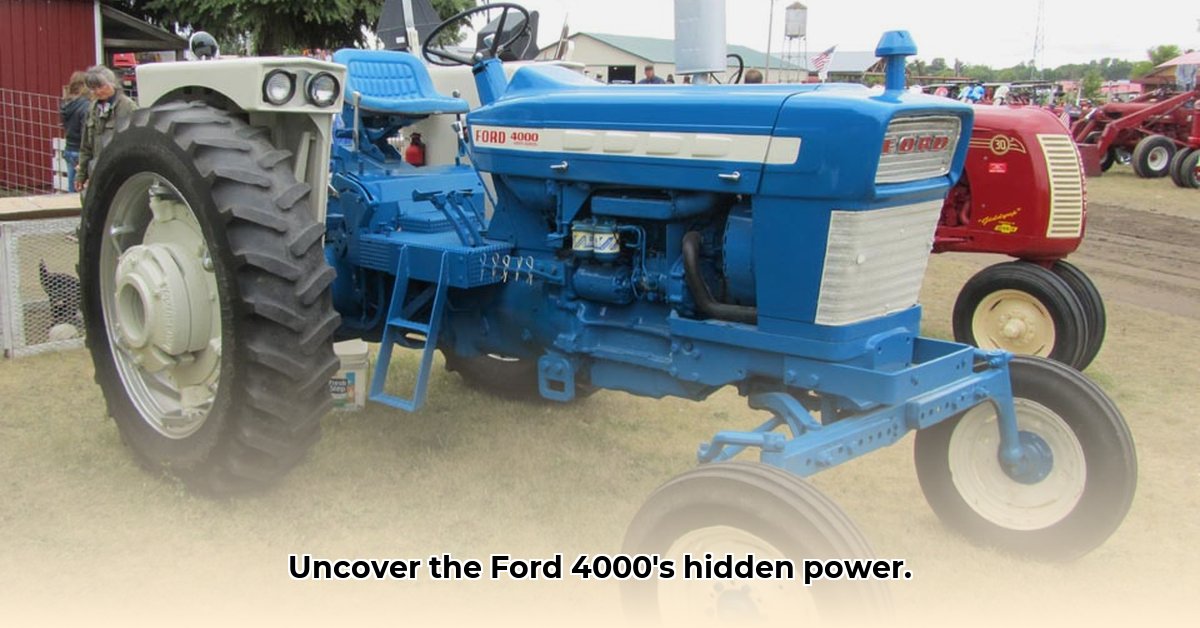
Ford 4000 Tractor: A Deep Dive into the Farming Icon
The Ford 4000 tractor isn't just a machine; it's a symbol of agricultural innovation and enduring reliability. This comprehensive guide delves into the specifications of this iconic workhorse, exploring its evolution, key features, and troubleshooting common issues. Whether you're a seasoned collector, a novice mechanic, or simply fascinated by its legacy, this detailed exploration will provide valuable insights. For even more detailed specifications, check out this helpful resource: Ford 4000 Data.
Engine Power and Options: The Heart of the Ford 4000
The Ford 4000's powertrain was a defining characteristic. Early models typically featured a robust 3.1-liter gasoline engine, ideal for lighter farm tasks. However, as agricultural demands intensified, Ford responded with a more powerful 3.3-liter diesel engine option, offering increased torque and efficiency for heavier workloads. A less common variant included a 3.1-liter liquid propane gas (LPG) engine, demonstrating Ford's commitment to fuel diversity. The PTO horsepower ranged from approximately 45 to 47, allowing the Ford 4000 to handle a diverse range of agricultural operations. How did this power range compare to competitors of the same era? Further research into contemporary tractor specifications would illuminate this aspect of its market positioning.
Transmission and Handling: Precision and Control
The Ford 4000's transmission significantly influenced its operational capabilities. Early models utilized an 8-speed dual-range transmission, providing a decent range of gearing. Later models received a substantial upgrade, featuring a 10-speed Select-O-Speed system. This enhancement offered a finer selection of gear ratios, translating to smoother operation, improved fuel economy, and a more responsive feel. This upgrade is a textbook example of how incremental technological advancements improved both performance and user experience. Did this improved transmission system make a noticeable difference in fuel consumption? Comparative studies of fuel efficiency across various model years would be instructive.
Hydraulic Power: Versatility and Adaptability
The Ford 4000’s hydraulic system was key to its versatility. While the basic hydraulic capacity remained relatively consistent across model years, variations likely existed in pump flow rates and pressure, depending on the precise configuration. This nuanced difference is critical for those undertaking restoration or repairs. The ability to easily attach various implements, including front-end loaders such as the Ford 771 and 772, vastly expanded the tractor's utility, making it an invaluable tool for a broader range of agricultural tasks. How did the hydraulic system's capabilities compare to other tractors of the same era and power class? Examining contemporary tractor manuals would provide a useful comparative benchmark.
Design and Technological Context: Simplicity and Reliability
Compared to modern tractors, the Ford 4000 possessed a simpler design. Features like power-assisted three-point hitches and advanced computerized hydraulic controls were absent. Furthermore, it lacked a factory-installed cab, exposing the operator to the elements. However, this simplicity was a key factor in its affordability and ease of maintenance. This design philosophy reflected the technological landscape of its era, prioritizing straightforward reliability over complex features. This approach resonated with many farmers who valued uncomplicated machinery that was easy to understand and repair. What design choices made the Ford 4000 so appealing to a broad range of farmers? Understanding its cultural and economic context is essential.
Ford 4000 Specs Across Model Years: A Comparative Overview
This table summarizes key specifications across different Ford 4000 models. Note that these represent general ranges; precise specifications may vary slightly depending on the build date and available documentation.
| Feature | Early Models (approx. 1962-1968) | Later Models (approx. 1968-1975) |
|---|---|---|
| Engine | Primarily 3.1L Gasoline | 3.3L Diesel, 3.1L LPG, 3.3L Gasoline |
| Transmission | 8-speed Dual-Range | 10-speed Select-O-Speed |
| PTO Horsepower | Approximately 45 hp | Approximately 45-47 hp |
| Key Differences | Simpler engine and transmission | Increased power and transmission options |
Troubleshooting the Ford 4000 Hydraulic System: A Step-by-Step Guide
Actionable Insights:
- Check Hydraulic Fluid Level: Low fluid levels frequently cause lifting issues.
- Inspect for Leaks: Leaks in lines, connections, and cylinders can quickly deplete the fluid.
- Test Unloading Valve: A malfunctioning unloading valve may prevent proper lifting.
Understanding the Ford 4000 Hydraulic System
The hydraulic system powers the three-point hitch, critical for lifting and lowering implements. It involves a pump, lines, valves, and cylinders. Understanding these components is paramount before troubleshooting.
Step-by-Step Troubleshooting
Check Hydraulic Fluid Level: This is the simplest yet often most effective first step. Add fluid if necessary, using the correct type as specified in your owner's manual.
Inspect for Leaks: Carefully examine all hydraulic lines, connections, and cylinders for leaks, paying close attention to wheel cylinders and O-rings.
Test the Unloading Valve: This valve regulates hydraulic pressure release. Refer to your owner's manual for model-specific testing instructions.
Check Linkage: Inspect linkages for any binding or abnormal movement.
Seek Professional Help: If the problem persists after these steps, professional assistance is recommended.
Model-Specific Considerations: Precision and Accuracy
Remember that component locations and specifications differ slightly between various Ford 4000 models. Always consult your owner's manual for model-specific information to ensure accurate repair procedures.
Preventative Maintenance: Proactive Measures
Regular maintenance, such as fluid level checks and visual inspections, is crucial in preventing major hydraulic system issues. This proactive approach can save significantly on repair costs in the long run.